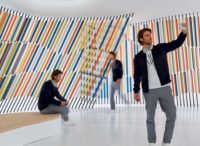The competition was conducted in collaboration with the National Building Museum (NBM) in Washington, D.C., whose current exhibition of the same name (on display through October) features examples and analysis of 14 green communities located throughout the world. Taking its cue from the exhibition, the competition’s call for entries asked students to reimagine a specific area in their towns, considering issues such as reuse, remediation, conservation, sanitation, and water management, among other elements in contemporary sustainable planning.
The entries submitted represented 1,322 students and 200 faculty members from 76 universities. U.S. teams won the first, second, and third place awards. The jury also named two honorable mentions and nine citations.
The first place project was created by Dylan Barlow, Kyle Belcher, and Geoffrey Gregory from the California College of the Arts in San Francisco. Their project, titled “Urban Reef,” re-imagines San Francisco’s Pier 70 as a public showplace for green energy and sustainable food production. The jury applauded the project for “a dramatic analysis” and “visionary form,” adding that the team “marries a big idea directly related with the topic with an architectural solution.”
The second place winner is “edgEcology: Change the Edges, Change the City,” by Chris Hardy, Tomoki Takebayashi, Chris Gruber, and Rachel Kunreuther of Cornell University. Their proposal features a series of environmental interventions in Buffalo, New York.
Third place goes to Amalia Bamis, Kristen Dahlquist, and Li Yu of the University of South Florida for “Urban Green Community: Revitalizing the South Nebraska Distract” —a reworking of an area of Tampa, Florida, into a walkable community.
All three teams will present their projects at an event scheduled for July 28 at the National Building Museum.
The Green Community competition is the latest in a tradition of competition planning that extends back 50 years, according to ACSA project manager, Eric Ellis. ACSA conducts around four competitions a year, and recent projects have tended to focus on sustainability, but from a smaller-scale, architectural perspective.
Green Community, says Ellis, was an opportunity to “focus not just on a single discipline,” but to encourage interdisciplinary collaboration. Though not mandatory, the brief suggested that projects be produced by teams, promoting dialogue between the sometimes insular fields of architecture, planning, and landscape architecture.
“We encouraged students to think about sustainability as it relates to their community, but it was done in a collaborative fashion, one that breaks down the barriers between disciplines. And that mimics what is happening in the field right now,” explains Scott Kratz, the NBM’s vice president of education.
The jurors for the competition were Ivan Harbour, of Rogers Stirk Harbour + Partners; Robert Ivy, editor in chief of Architectural Record; Rachelle Levitt, of the Urban Land Institute; and Harry Van Oudenallen, of the University of Wisconsin-Milwaukee. Ivy was impressed with the global scope of the submissions, noting that he and other jurors were "heartened to see so many students from around the world engaged in a topic of vital importance for our future."
|















Post a comment to this article
Report Abusive Comment